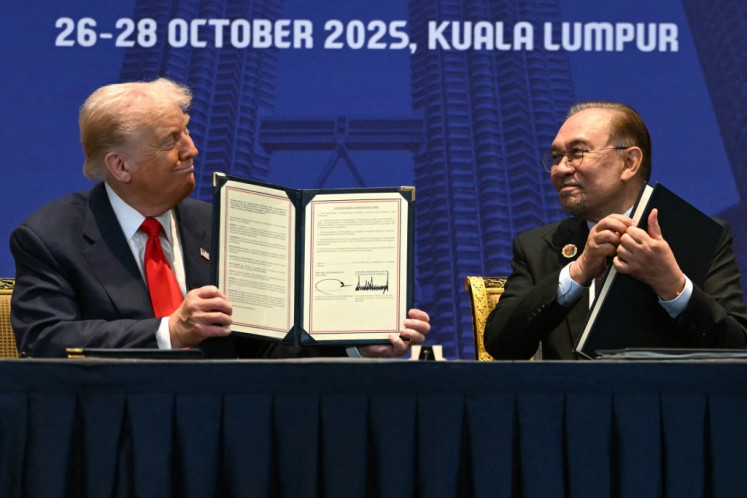Popular Reads
Top Results
Can't find what you're looking for?
View all search resultsPopular Reads
Top Results
Can't find what you're looking for?
View all search resultsArt for love or money
Up close: A visitor passes through I
Change text size
Gift Premium Articles
to Anyone
Up close: A visitor passes through I.G.N. Udiantara’s work titled Face Your Dark Side. In the eyes of art lovers, paintings offer not just pleasure, but also a promising investment. (JP/P.J.Leo)
You see your beloved across a crowded room, and your heart beats faster with desire. Where others see a simple painting, you see true love. You are determined to make it yours.
There are those who question why some people will spend hundreds of millions or even billions of rupiah on a simple painting, especially during a financial downturn. But as art lovers across the ages have proved, paintings offer not just pleasure, but also a promising investment.
“It’s true that the crisis has held back some people from buying paintings, but on the other hand, new collectors see it as the best time to start buying, because prices [of paintings] now are at a quite attractive or realistic level,” says Amir Sidharta, an art curator and owner of Sidharta Auctioneer.
Around six months ago, Amir says, those who wanted to start collecting paintings thought twice because a boom in the art market had put prices at their peak. But since the financial markets tumbled, he says, so have prices, giving potential collectors a chance to take another look.
Oei Hong Djien, an art collector who sits on the Singapore Art Museum’s board of directors, agrees. If the situation mirrors that of the 1998 financial crisis, he says, the art market is likely to experience a boom this year.
During the 1998 crisis, Oei reveals many people looked for the most convenient and promising ways to invest their money – including purchasing paintings.
“[At that time] they heard that paintings that were cheap would become expensive, so they were interested [in investing],” Oei says.
“Then that was it. The art market suddenly turned crowded in the middle of this economic crisis. It was weird.”
Collector and owner of Nadi Gallery, Biantoro Santoso, says that enjoyment tends not to be people’s first motivation for buying art.
“I would say there are more people who collect for investment, for either the short term or the long term,” he says. “Some collectors will keep their paintings for years until they can sell them again with high returns.”
Drawing on this “investment and enjoyment” dichotomy, artist Hanafi identifies the three “faces” of painting collectors in Indonesia.
The first, he says, are the fanatic collectors, driven by passion, about whom “it can be said that that the primary motivation would be a genuine interest in and appreciation of art.”
This kind of collector “only sticks to the works of certain artists.
They usually have a deep [emotional] connection to the artists, and even buy the paintings directly from the artists.”
Fanatic collectors, Hanafi says, base their purchases on their own feelings. “They are not easily influenced by others. They also look at an art piece differently and come away with new insight as to its meanings.”
Oei would be one collector in this category – he has thousands of paintings in his two private galleries in his home in Magelang, Central Java. Oei often refuses offers from people interested in buying part of his collection, and passes on his paintings to other people “only
as gifts”.
The second type, according to Hanafi, finds pleasure and satisfaction only at the time of trade, whether buying or selling.
For them, he says, it is all about status and investment: “There is this phemonenon where some people enjoy ‘playing the game’ in the art market.”
Such buyers, he says, love to come to auctions just to show they can afford expensive paintings by raising their hands to bid.
“You know, some of them would feel proud to receive a call [from a buyer], asking ‘I heard you own that painting now, that you bid for it. Do you want to sell it?” Hanafi says. “They just love playing that kind of game.”
The third type of collector that Hanafi identifies is a combination of the first two, for whom art is both pleasure and business.
“This would be gallery owners, who keep their idealism in both ways,” Hanafi says. “It’s good this way for some artists, because they are helped [in promoting their works].”
Although some galleries, he adds, collect paintings just for appearances.
“They buy paintings by famous artists only as ‘window dressing’. They don’t sell them, but put them there to boost their image, and to make their other paintings appear to be in the same class as those [fine and expensive] paintings.”
“I’m not saying that’s a bad thing. It’s just that many things happen after a painting comes out of a studio. And I think artists and galleries need each other to survive.”
(Sri Wahyuni contributed to this story from Magelang, Central Java)










